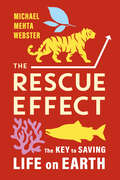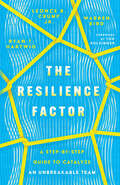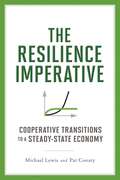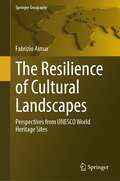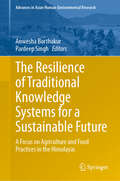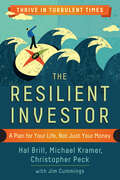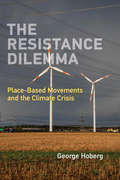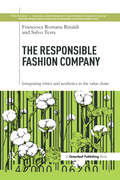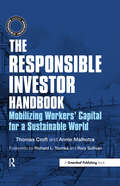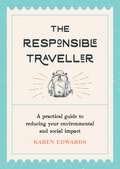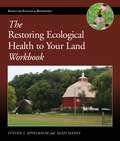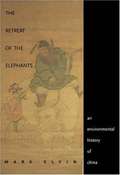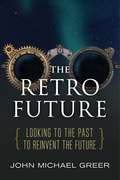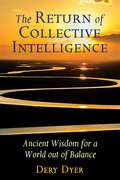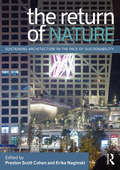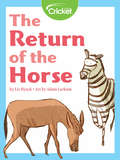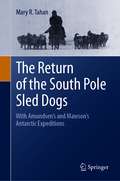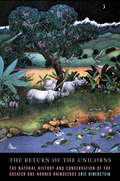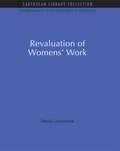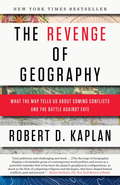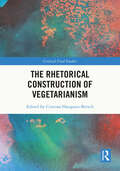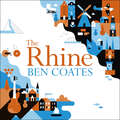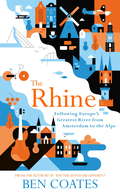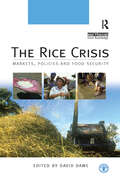- Table View
- List View
The Rescue Effect: The Key to Saving Life on Earth
by Michael Mehta Webster&“Details profound examples of life&’s resilience and makes a convincing case that the natural world still has a lot worth fighting for.&” —Paul Greenberg, New York Times bestselling author of Four Fish and The Climate Diet As climate change continues to intensify, the outlook for life on Earth often seems bleak. Yet hope for the future can be found in the &“rescue effect,&” which is nature&’s innate ability to help organisms persist during hard times. Like a thermostat starting the air conditioning when a room gets too warm, the rescue effect automatically kicks in when organisms are stressed or declining. In The Rescue Effect, Michael Mehta Webster reveals the science behind nature&’s inherent resilience, through compelling stories of species that are adapting to the changing world—including tigers in the jungles of India, cichlid fish in the great lakes of Africa, and corals in the Caribbean. In some cases, like the mountain pygmy-possum in the snowy mountains of southeast Australia, we risk losing species without intensive help from people. As observers to—and the cause of—species declines, we must choose whether and how to help, while navigating challenging questions about emerging technologies and the ethics of conservation actions. Ultimately, Webster argues that there are good reasons to expect a bright future, because everywhere we look, we can see evidence that nature can rescue many species from extinction; and when nature alone is not up to the task, we can help. Combining rigorous research with gripping storytelling, The Rescue Effect provides the cautious optimism we need to help save life on Earth.
The Resilience Factor: A Step-by-Step Guide to Catalyze an Unbreakable Team
by Warren Bird Ryan T. Hartwig Léonce B. Crump Jr.Want to unleash the "remarkable" in your team? The potential of a team of God-inspired, talented, committed people is boundless. But without resilience—including the savvy and skill to get up again (and again) when the going gets tough—teams simply cannot thrive or lead well. Resilience is what sets great leaders and teams apart from those that literally fall apart. It's what's missing when great organizations lose steam. Ryan T. Hartwig, Léonce B. Crump Jr., and Warren Bird have worked with team members in many kinds of churches and Christian organizations, served on numerous teams, and surfaced the best research on teams. In The Resilience Factor, they distill this wisdom into a series of practical steps that promise to both inspire and equip teams to move from floundering to flourishing. Filled with examples of top-performing teams, individual and group reflection questions, diagnostic tools, and team activities, The Resilience Factor promises to become the go-to resource for leaders who want to release remarkable resilience in their teams.
The Resilience Imperative: Cooperative Transitions to a Steady-State Economy
by Michael Lewis Pat Conaty“[The authors] argue that with more integration and cooperation between businesses, governments and communities, a more sustainable economy is possible.” —The Environmental MagazineWe find ourselves between a rock and a hot place—compelled by the intertwined forces of peak oil and climate change to reinvent our economic life at a much more local and regional scale. The Resilience Imperative argues for a major SEE (social, ecological, economic) change as a prerequisite for replacing the paradigm of limitless economic growth with a more decentralized, cooperative, steady-state economy.The authors present a comprehensive series of strategic questions within the broad areas of:Energy sufficiencyLocal food systemsInterest-free financingAffordable housing and land reformSustainable community developmentEach section is complemented by case studies of pioneering community initiatives rounded out by a discussion of transition factors and resilience reflections.With a focus on securing and sustaining change, this provocative book challenges deeply embedded cultural assumptions. Profoundly hopeful and inspiring, The Resilience Imperative affirms the possibilities of positive change as it is shaped by individuals, communities, and institutions learning to live within our ecological limits.“Resilience is the watchword for our dawning era of economic and environmental instability . . . The Resilience Imperative is exactly what’s needed to get us moving in the right direction.” —Richard Heinberg, author of Power: Limits and Prospects for Human Survival“Exceptionally valuable—in vision, in strategic understanding, in concrete ways to build forward. A handbook for a morally meaningful and sustainable future!” —Gar Alperovitz, author of America Beyond Capitalism
The Resilience of Cultural Landscapes: Perspectives from UNESCO World Heritage Sites (Springer Geography)
by Fabrizio AimarThis book explores the possibility of building the resilience of the UNESCO cultural landscapes, both using theoretical conceptions and practical strategies and actions. Two case studies have been selected, one in Italy and one in China, which have then been explored for the first time in such a comparative way. Different notions of landscape, as well as the driving force of changes affecting these landscapes, are examined and compared. Moreover, the perceptions of the local communities regarding these landscapes are examined, using online questionnaires with over 400 participants. This research highlights the need for an integrated management system, building stronger rural communities able to manage change and continuity. Five pillars to build the resilience of these landscapes have been provided, with schemes and figures, requiring a people-centered approach in their management. This book demonstrates strong connections between identity and landscape resilience, especially in inlandareas where the sense of identity is most prominent. Furthermore, it is structured to make it possible to replicate this investigation in ordinary case studies, i.e. ordinary landscapes. Scholars and professionals interested in cultural landscapes and heritage conservation are target of this book, as well as site managers.
The Resilience of Traditional Knowledge Systems for a Sustainable Future: A Focus on Agriculture and Food Practices in the Himalayas (Advances in Asian Human-Environmental Research)
by Pardeep Singh Anwesha BorthakurThis book is an effort to draw attention to the resilience of traditional knowledge systems for a sustainable future in the Himalayas with a particular focus on agriculture and food practices. Through examples from the region, it underscores the importance of these practices in navigating contemporary global environmental challenges. The Himalayan region, known for its socio-cultural diversity and unique agricultural ecology, emerges as a major hotspot of climate change. Therefore, acknowledging and recognizing the lived experiences of the locals along with their traditional knowledge associated with agriculture and food systems becomes imperative for devising adaptation and mitigation strategies amidst the unfolding environmental and climate crisis. Drawing upon insights from local communities and experts deeply rooted in the Himalayan context, this book not only documents traditional agricultural and food systems but also sheds light on the pressing anthropogenic challenges threatening their sustainability. We believe that research and documentation of traditional knowledge practices of the local and indigenous communities are essential for tackling the current and projected global environmental challenges.This book advocates for a holistic approach to addressing both current and future global environmental challenges. It serves as a timely call to action for researchers, policymakers, and practitioners alike.
The Resilient Investor: A Plan for Your Life, Not Just Your Money
by Michael Kramer Christopher Peck Hal BrillIf you want to build a better life and a better world—and really be prepared for any possible future in these turbulent times—you need to become a resilient investor! This trailblazing guide will expand your ideas of investing way beyond Wall Street. Your time, your energy, and the things you own are investments too, and you'll learn to diversify them in ways that move you toward your life goals. The Resilient Investment Map lays out all your assets—personal and physical as well as financial—and then provides three essential, timely strategies (Close to Home, Sustainable Global Economy, and Evolutionary Investing) that will help you grow each of them. The goal is to become more resilient: able to anticipate disturbance, rebuild as necessary, and improve when possible. You'll discover that the choices making you more resilient also enhance our communities, our economy, and the planet—building real wealth for all.
The Resistance Dilemma: Place-Based Movements and the Climate Crisis (American and Comparative Environmental Policy)
by George HobergHow organized resistance to new fossil fuel infrastructure became a political force, and how this might affect the transition to renewable energy.Organized resistance to new fossil fuel infrastructure, particularly conflicts over pipelines, has become a formidable political force in North America. In this book, George Hoberg examines whether such place-based environmental movements are effective ways of promoting climate action, if they might inadvertently feed resistance to the development of renewable energy infrastructure, and what other, more innovative processes of decision-making would encourage the acceptance of clean energy systems. Focusing on a series of conflicts over new oil sands pipelines, Hoberg investigates activists&’ strategy of blocking fossil fuel infrastructure, often in alliance with Indigenous groups, and examines the political and environmental outcomes of these actions. After discussing the oil sands policy regime and the relevant political institutions in Canada and the United States, Hoberg analyzes in detail four anti-pipeline campaigns, examining the controversies over the Keystone XL, the most well-known of these movements and the first one to use infrastructure resistance as a core strategy; the Northern Gateway pipeline; the Trans Mountain pipeline; and the Energy East pipeline. He then considers the &“resistance dilemma&”: the potential of place-based activism to threaten the much-needed transition to renewable energy. He examines several episodes of resistance to clean energy infrastructure in eastern Canada and the United States. Finally, Hoberg describes some innovative processes of energy decision-making, including strategic environment assessment, and cumulative impact assessment, looking at cases in British Columbia and Lower Alberta.
The Responsible Fashion Company: Integrating Ethics and Aesthetics in the Value Chain
by Francesca Romana Rinaldi Salvo TestaIn The Responsible Fashion Company, Rinaldi and Testa argue that the fashion industry is at a crossroads: the need for a global shift to a sustainable model has never been more urgent. Yet, they demonstrate that we are witnessing a revolution led by conscious consumers and enlightened companies, who are redefining the rules of the fashion market. The question is: when will the rest of the industry catch up? Rinaldi and Testa raise a fundamental but often neglected issue in the fashion sustainability debate: long-term equilibrium can only be achieved by integrating economic goals with environmental, social and ethical values. "The Responsible Fashion Company" provides a clear overview of the theory, challenges and opportunities of sustainability in the industry and demonstrates how fashion companies can achieve competitive advantage through sustainable innovation. The authors show how leading fashion companies are challenging traditional thinking and present inspiring examples from pioneers such as Gucci, Levi's, Timberland and Brunello Cucinelli, who create quality products without leaving a negative impact behind.Refreshing and timely, The Responsible Fashion Company is essential reading for the socially conscious consumer and anyone with a professional or personal interest in the fashion, design and luxury industries.
The Responsible Investor Handbook: Mobilizing Workers' Capital for a Sustainable World (The Responsible Investment Series)
by Thomas Croft Annie MalhotraFor decades, workers’ capital stewards have invested wisely to provide a secure retirement for millions of people around the world. This money – our money – represents an enormous share of economic and capital market wealth. It has seeded and grown innumerable innovative industries that have had far-reaching impacts. However, the 2008 financial crisis has seriously threatened these trusted assets and drained away prosperity.In response, a growing number of investors are moving towards responsible investment policies and strategies, addressing the rising expectations of consumers and benefiting from the financial advantages such strategies bring. Everyday citizens now want to see their investments not only do well, but do good. But, what constitutes responsible investment, and how can it be undertaken in practice? What is the impact of responsible investment strategies on investment performance? How can trustees, managers and advisors implement these strategies in line with their fiduciary responsibilities? How can plan trustees and staff members convince all stakeholders of the need to invest in resilient growth?The Responsible Investor Handbook, commissioned by the AFL-CIO and global progressive investors, is a lay-friendly “how-to” manual, sharing the best in responsible investment practice with capital stewards and other policy leaders who want to do the right thing with our common wealth.This invaluable toolkit enables readers to: Understand the pioneering role of workers’ capital in building infrastructure and vital services Devise a responsible investment strategy Select and monitor service providers Bring on board stakeholders with conflicting interests Avoid short-termism The Responsible Investor Handbook is the first book devoted to aligning the long-term investment priorities of working people with capital stewards and the financial complex that manages their assets. It is an essential read for trustees and capital stewards seeking the positive outcomes of a responsible investment strategy; pension and institutional investors looking to realign their strategies with the interests of workers and citizens; and any professional seeking a better understanding of the importance of responsible investment and its impact on capital markets.
The Responsible Traveller: A Practical Guide to Reducing Your Environmental and Social Impact, Embracing Sustainable Tourism and Travelling the World With a Conscience
by Karen EdwardsThe Responsible Traveller is your ticket to sustainable and ethical travel. This pocket-sized book provides the knowledge and tools that can help you to explore the world with a lighter footprint.Whether you travel out of curiosity, to find respite, to remind yourself of how vast and wonderful our planet is, or in search of life-shaping adventures, having the freedom to explore can be exhilarating and hugely rewarding. However we owe it to the people, cultures, ecosystems and wildlife that we encounter along the way to travel with respect; to preserve our beautiful world for generations to come.The Responsible Traveller will show you how to make actionable changes that result in more thoughtful and adventurous travels, while also doing our very best for Planet Earth. Through case studies and storytelling, you’ll learn about the environmental and social effects of tourism and gain a deeper understanding of cultural sensitivity. And through simple, achievable tips and practical lifestyle changes, you’ll discover how you can make an almighty difference in reducing your impact. Empowered with this information, perhaps your next adventure will be inspired by consideration, understanding and compassion.
The Responsible Traveller: A Practical Guide to Reducing Your Environmental and Social Impact, Embracing Sustainable Tourism and Travelling the World With a Conscience
by Karen EdwardsThe Responsible Traveller is your ticket to sustainable and ethical travel. This pocket-sized book provides the knowledge and tools that can help you to explore the world with a lighter footprint.Whether you travel out of curiosity, to find respite, to remind yourself of how vast and wonderful our planet is, or in search of life-shaping adventures, having the freedom to explore can be exhilarating and hugely rewarding. However we owe it to the people, cultures, ecosystems and wildlife that we encounter along the way to travel with respect; to preserve our beautiful world for generations to come.The Responsible Traveller will show you how to make actionable changes that result in more thoughtful and adventurous travels, while also doing our very best for Planet Earth. Through case studies and storytelling, you’ll learn about the environmental and social effects of tourism and gain a deeper understanding of cultural sensitivity. And through simple, achievable tips and practical lifestyle changes, you’ll discover how you can make an almighty difference in reducing your impact. Empowered with this information, perhaps your next adventure will be inspired by consideration, understanding and compassion.
The Restoring Ecological Health to Your Land Workbook (Science Practice Ecological Restoration)
by Steven I. Apfelbaum Alan HaneyThis is the first practical guidebook to give restorationists and would-be restorationists with little or no scientific training or background the "how to" information and knowledge they need to plan and implement ecological restoration activities. The first part of the book introduces the process of ecological restoration in simple, easily understood language through specific examples drawn from the authors' experience in restoring their own lands. The second half shows how that same "thinking" and "doing" can be applied to North America's major ecosystems and landscapes in any condition or scale. No other ecological restoration book leads by example and first-hand experience like this one. It represents a unique and important contribution to the literature on restoration.
The Retreat of the Elephants: An Environmental History of China
by Mark ElvinOpening a door into the Chinese past, this book provides both a new perspective on long-term Chinese history and an explanation of the roots of China's current environmental crisis.
The Retro Future: Looking to the Past to Reinvent the Future
by John Michael GreerThe author of The Long Descent examines a solution for the troubles of our modern age: technical regression.To most people paying attention to the collision between industrial society and the hard limits of a finite planet, it’s clear that things are going very, very wrong. We no longer have unlimited time and resources to deal with the crises that define our future, and the options are limited to the tools we have on hand right now.This book is about one very powerful option: deliberate technological regression.Technological regression isn’t about “going back”—it’s about using the past as a resource to meet the needs of the present. It starts from the recognition that older technologies generally use fewer resources and cost less than modern equivalents, and it embraces the heresy of technological choice—our ability to choose or refuse the technologies pushed by corporate interests.People are already ditching smartphones and going back to “dumb phones” and land lines and e-book sales are declining while printed books rebound. Clear signs among many that blind faith in progress is faltering and opening up the possibility that the best way forward may well involve going back.A must-read for anyone willing to think the unthinkable and embrace the possibilities of a retro future.Praise for The Retro Future“Whether or not you accept John Michael Greer’s argument that a deindustrialized future is inevitable, you’ll appreciate his call for the freedom to select the best technologies of the past—worthy and sustainable tools, not pernicious prosthetics. Greer’s vision of a “post-progress” world is clear, smart, and ultimately hopeful.” —Richard Polt, professor of philosophy, Xavier University; author, The Typewriter Revolution: A Typist’s Companion for the 21st Century“What might your life be like without an automobile, TV, or a mobile phone? Ask John Michael Greer, who lives that way and recommends it as practice for the soon-to-be-normal. Greer says we are embarked upon the post-progress era. Climate change, loose nukes, and resource exhaustion are among its many challenges. In The Retro Future, Greer looks backward to mark the way forward.” —Albert Bates, author, The Post-Petroleum Survival Guide, The Biochar Solution, and The Paris Agreement
The Return of Collective Intelligence: Ancient Wisdom for a World out of Balance
by Dery DyerReveals how we can each reconnect to collective intelligence and return our world to wholeness, balance, and sanity • Explains how collective intelligence manifests in flocks of birds, instantaneous knowing in indigenous peoples, and the power of sacred places • Offers ways for us to reconnect to the infinite source of wisdom that fuels collective intelligence and underscores the importance of ceremony, pilgrimage, and initiation • Draws on recent findings in New Paradigm science, traditional teachings from indigenous groups from North, South, and Central America and Siberia, as well as sacred geometry, deep ecology, and expanded states of consciousness For our ancestors, collective intelligence was a normal part of life. We see it today as the mysterious force that enables flocks of birds, swarms of bees, and schools of fish to function together in perfect synchrony, communicating and cooperating at some undetectable level. At its most subtle, it&’s an instantaneous knowing, shared by members of a group, of the wisest course of action that will benefit all. As Dery Dyer reveals, collective intelligence still resides within each of us, and it is the key to restoring balance and harmony to our world. She shows how it occurs spontaneously when individuals who share a need and a purpose instinctively &“self-organize&” into a group and function with no leader or central authority. Such groups exhibit abilities much greater than what any of their members possess individually--or what can be replicated with artificial intelligence. Dyer explains, due to an unquestioning dependence on technology, modern humanity has forgotten how to connect with collective intelligence and fallen into collective stupidity, otherwise known as mob mind or groupthink, which is now endangering the interconnected web of life on Earth. Drawing on recent findings in New Paradigm science, traditional teachings from indigenous groups, as well as sacred geometry, deep ecology, and expanded states of consciousness, the author shows how the ability to think and act collectively for the highest good is hardwired in all living beings. She explains how to release ourselves from enslavement by technology and use it more wisely toward the betterment of all life. Underscoring the vital importance of ceremony, pilgrimage, and initiation, she offers ways for us to reconnect to the infinite source of wisdom that fuels collective intelligence and which manifests everywhere in the natural world. Revealing that once we relearn how to hear the Earth, we can heal the Earth, Dyer shows how each of us has a vital role to play in restoring our world to wholeness.
The Return of Nature: Sustaining Architecture in the Face of Sustainability
by Preston Scott Cohen Erika NaginskiThe Return of Nature asks you to critique your conception of nature and your approach to architectural sustainability and green design. What do the terms mean? Are they de facto design requirements? Or are they unintended design replacements? The book is divided into five parts giving you multiple viewpoints on the role of the relations between architecture, nature, technology, and culture. A detailed case study of a built project concludes each part to help you translate theory into practice. This holistic approach will allow you to formulate your own theory and to adjust your practice based on your findings. Will you provoke change, design architecture that responds to change, or both? Coedited by an architect and a historian, the book features new essays by Robert Levit, Catherine Ingraham, Sylvia Lavin, Barry Bergdoll, K. Michael Hays, Diane Lewis, Andrew Payne, Mark Jarzombek, Jean-Francois Chevrier, Elizabeth Diller, Antoine Picon, and Jorge Silvetti. Five case studies document the work of MOS Architects, Michael Bell Architecture, Steven Holl Architects, George L. Legendre, and Preston Scott Cohen.
The Return of the Horse
by Liz HuyckHorses began 55 million years ago in North America before migrating to Asia. One day, Europeans would bring horses back to the plains of North America.
The Return of the South Pole Sled Dogs: With Amundsen’s and Mawson’s Antarctic Expeditions
by Mary R. TahanThis book documents the return of the surviving sled dogs of the Norwegian Antarctic Expedition of 1910–1912 from Antarctica, where they had helped Roald Amundsen become the first human to reach the South Pole. This book is the sequel to the highly acclaimed Roald Amundsen’s Sled Dogs: The Sledge Dogs Who Helped Discover the South Pole. It chronicles how the sled dogs were used internationally to further promote the expedition’s great achievement and follows some of the dogs as they undertake subsequent expeditions – with Douglas Mawson’s Australasian Antarctic Expedition of 1911–1914, which made scientific discoveries, and with Arve Staxrud’s Norwegian Arctic Rescue Mission of 1913, which saved members of the Herbert Schröder-Stranz German Arctic Expedition. The book tracks the remaining 39 sled dogs to their next challenging adventures and their final destinations in Argentina, Norway, Antarctica, and Australia.Like its predecessor, the book portrays how Amundsen continued to utilize the Polar dogs – both in their lives and in their deaths – to propel his career and solidify his expedition's image.
The Return of the Unicorns: The Natural History and Conservation of the Greater One-Horned Rhinoceros (Biology and Resource Management Series)
by Eric DinersteinBeginning in 1984, Eric Dinerstein led a team directly responsible for the recovery of the greater one-horned rhinoceros in the Royal Chitwan National Park in Nepal, where the population had once declined to as few as 100 rhinos. The Return of the Unicorns is an account of what it takes to save endangered large mammals. In its pages, Dinerstein outlines the multifaceted recovery program—structured around targeted fieldwork and scientific research, effective protective measures, habitat planning and management, public-awareness campaigns, economic incentives to promote local guardianship, and bold, uncompromising leadership—that brought these extraordinary animals back from the brink of extinction. In an age when scientists must also become politicians, educators, fund-raisers, and activists to safeguard the subjects that they study, Dinerstein's inspiring story offers a successful model for large-mammal conservation that can be applied throughout Asia and across the globe.
The Revaluation of Women's Work (Environmental and Resource Economics Set)
by Sheila LewenhakThis book provides a survey and analysis of the different ways in which women's work is valued throughout the world. It challenges the narrow definition of work as paid work, as that excludes so many of women's activities. It looks at ways in which women's worth has been consistently undervalued in industrial as well as non-industrial countries, in socialist as well as free-enterprise economies. These practices distort the national product of countries heavily dependent on women's labour, but, above all, they are among the most obvious marks of the exploitation of women. Technological changes are already altering established female/male divisions of labour. Transnational enterprises, often located in Special Economic Zones, are reducing differences between industrial and nonindustrial countries. Valuing women's work correctly, whether unpaid in the home or underpaid outside it, is part of the battle against discrimination and poverty. Men who do similar work also benefit. It is the crucial step towards the achievement of male/female equality. The book will be particularly valuable for those concerned with the issues, in trade unions, women's groups, international agencies and NGOs and for course in economics and social studies.
The Revenge of Geography: What the Map Tells Us About Coming Conflicts and the Battle Against Fate
by Robert D. KaplanIn this provocative, startling book, Robert D. Kaplan, the bestselling author of Monsoon and Balkan Ghosts, offers a revelatory new prism through which to view global upheavals and to understand what lies ahead for continents and countries around the world. In The Revenge of Geography, Kaplan builds on the insights, discoveries, and theories of great geographers and geopolitical thinkers of the near and distant past to look back at critical pivots in history and then to look forward at the evolving global scene. Kaplan traces the history of the world's hot spots by examining their climates, topographies, and proximities to other embattled lands. The Russian steppe's pitiless climate and limited vegetation bred hard and cruel men bent on destruction, for example, while Nazi geopoliticians distorted geopolitics entirely, calculating that space on the globe used by the British Empire and the Soviet Union could be swallowed by a greater German homeland. Kaplan then applies the lessons learned to the present crises in Europe, Russia, China, the Indian subcontinent, Turkey, Iran, and the Arab Middle East. The result is a holistic interpretation of the next cycle of conflict throughout Eurasia. Remarkably, the future can be understood in the context of temperature, land allotment, and other physical certainties: China, able to feed only 23 percent of its people from land that is only 7 percent arable, has sought energy, minerals, and metals from such brutal regimes as Burma, Iran, and Zimbabwe, putting it in moral conflict with the United States. Afghanistan's porous borders will keep it the principal invasion route into India, and a vital rear base for Pakistan, India's main enemy. Iran will exploit the advantage of being the only country that straddles both energy-producing areas of the Persian Gulf and the Caspian Sea. Finally, Kaplan posits that the United States might rue engaging in far-flung conflicts with Iraq and Afghanistan rather than tending to its direct neighbor Mexico, which is on the verge of becoming a semifailed state due to drug cartel carnage. A brilliant rebuttal to thinkers who suggest that globalism will trump geography, this indispensable work shows how timeless truths and natural facts can help prevent this century's looming cataclysms.Advance praise for The Revenge of Geography "Robert D. Kaplan wields geography like a scalpel, using it to examine international relations and conflicts that globalization fails to explain. The Revenge of Geography is a sagacious account of how geography has shaped the world we know--and what this means for the future. Kaplan's wedding of historical and present-day analysis on a region-by-region basis makes for a well-researched, entertaining, and informative read that cannot be ignored."--Ian Bremmer, president of Eurasia Group and author of Every Nation for Itself "The importance of geography in shaping history is the great issue that Robert Kaplan tackles in this extraordinary book. Thirty years of scholarship and travel lie behind his recounting of human triumphs and conflicts through the ages. At the heart of his wide-ranging analysis is his belief in the abiding influence of geography on human behavior, now and in the future."--James Hoge, counselor, Council on Foreign RelationsFrom the Hardcover edition.
The Rhetorical Construction of Vegetarianism (Critical Food Studies)
by Cristina Hanganu-BreschThis book explores themes in the rhetoric of vegetarian discourse. A vegan practice may help mitigate crises such as climate change, global health challenges, and sharpening socioeconomic disparities, by ensuring both fairness in the treatment of animals and food justice for marginalized populations. How the message is spread is crucial for these aims. Vegan practices thus uncover tensions between individual dietary choices and social justice activism, between ego and eco, between human and animal, between capitalism and environmentalism, and within the larger universe of theoretical and practical ethics. The chapters apply rhetorical methodologies to understand vegan/vegetarian discourse, emphasizing, for example, vegan/vegetarian rhetoric through the lens of polyphony, the role of intersectional rhetoric in becoming vegan, as well as ecofeminist, semiotic, and discourse theory approaches to veganism. The book aims to show that a rhetorical understanding of vegetarian and vegan discourse is crucial for the goals of movements promoting veganism. The book is intended for a wide interdisciplinary audience of scholars, researchers, and individuals interested in veganism, food and media studies, rhetorical studies, human-animal studies, cultural studies and related disciplines. It urges readers to examine vegan discourses seriously, not just as a matter of personal choice or taste but as one vital for intersectional justice and our planetary survival.
The Rhine: Following Europe's Greatest River from Amsterdam to the Alps
by Ben Coates*SHORTLISTED FOR THE STANFORD DOLMAN TRAVEL BOOK OF THE YEAR AWARD*Ben Coates, author of Why the Dutch are Different, cycles the Rhine river from mouth to source, discovering the mark it makes on Europe.The Rhine is one of the world's greatest rivers. Once forming the outer frontier of the Roman Empire, it flows 800 miles from the social democratic playground of the Netherlands, through the industrial and political powerhouses of Germany and France, to the wealthy mountain fortresses of Switzerland and Liechtenstein. For five years, Ben Coates lived alongside a major channel of the river in Rotterdam, crossing it daily, swimming and sailing in its tributaries. In The Rhine, he sets out by bicycle from the Netherlands where it enters the North Sea, following it through Germany, France and Liechtenstein, to its source in the icy Alps. He explores the impact that the Rhine has had on European culture and history and finds out how influences have flowed along and across the river, shaping the people who live alongside it. Blending travelogue and offbeat history, The Rhine tells the fascinating story of how a great river helped shape a continent.(P) 2021 Hodder & Stoughton Limited
The Rhine: Following Europe’s Greatest River from Amsterdam to the Alps
by Ben CoatesThe Rhine is one of the world's greatest rivers. Once forming the outer frontier of the Roman Empire, it flows 800 miles from the social democratic playground of the Netherlands, through the industrial and political powerhouses of Germany and France, to the wealthy mountain fortresses of Switzerland and Liechtenstein. For five years, Ben Coates lived alongside a major channel of the river in Rotterdam, crossing it daily, swimming and sailing in its tributaries. In The Rhine, he sets out by bicycle from the Netherlands where it enters the North Sea, following it through Germany, France and Liechtenstein, to its source in the icy Alps. He explores the impact that the Rhine has had on European culture and history and finds out how influences have flowed along and across the river, shaping the people who live alongside it. Blending travelogue and offbeat history, The Rhine tells the fascinating story of how a great river helped shape a continent.
The Rice Crisis: Markets, Policies and Food Security
by David DaweThe recent escalation of world food prices – particularly for cereals - prompted mass public indignation and demonstrations in many countries, from the price of tortilla flour in Mexico to that of rice in the Philippines and pasta in Italy. The crisis has important implications for future government trade and food security policies, as countries re-evaluate their reliance on potentially more volatile world markets to augment domestic supplies of staple foods. This book examines how government policies caused and responded to soaring world prices in the particular case of rice, which is the world's most important source of calories for the poor. Comparable case studies of policy reactions in different countries, principally across Asia, but also including the USA, provide the understanding necessary to evaluate the impact of trade policy on the food security of poor farmers and consumers. They also provide important insights into the concerns of developing countries that are relevant for future international trade negotiations in key agricultural commodities. As a result, more appropriate policies can be put in place to ensure more stable food supplies in the future. Published with the Food and Agriculture (FAO) Organization of the United Nations
